Geographical location of the forest
- The Costa Rican rain forest is located along the central American country near Costa Rica State and hence the name. The forest occupies approximately 180,000 hectares of land which is roughly 7.4%.
- This kind of rain forest receives a minimum annual rainfall of between 1750-2000 mm. Such types of forest are home to approximately 75% of the indigenous earth species.
- The forest is a home to approximately 3,000 living species which includes birds, reptiles, butterflies, amphibians and mammals.
Its conservation is therefore critical as it will greatly determine the presence and future survival of those living species. A single move towards deforestation will lead to loss of lives and habitat for the species. This is so considering that some species like amphibians dwells in a wet ecosystem. The continued rainy season contributes positively to the lives and well being of plant and animal species in the forest.
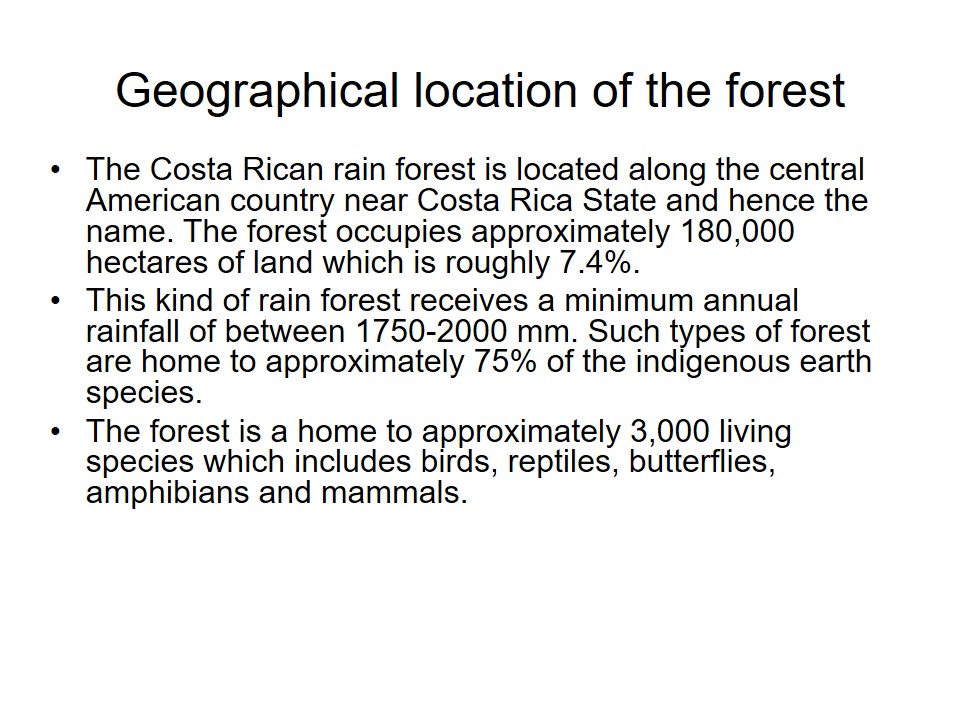
Abiotic components
- Rainfall is evenly distributed across the region but dry periods continues to be experienced noticeably January through April (Bonell & Bruijnzeel, 2004).
- The forest also has a great biological diversity considering that it has more than 1100 plant species in it. Since the vegetation not only act as food to the living species but also attract rainfall in the region, considerable measures have been reinstated by the government to protect the forest.
- The on-going deforestation has caused an alarming effect considering the magnitude of climatic damages that will accompany the region as a result of it (Vajpeyi,2008).
- Since Costa Rican forest was formed through volcanic archipelago, rich minerals are still contained in the soil formation.
- Costa Rica rainforest has enough amount of water and sunlight which is provide a canopy over the many living creatures in it.
The government has taken an initiative which aims at restricting and punishing the people who damage forests in order to attain their personal goals such as wealth accumulation. According to Vajpeyi (2008) economic gain is one of the possible reasons why people exploit forest. The continued demand of furniture products together with other materials like books that requires tree harvesting in the state has threatened the forestry survival.
The nutritional soil that emanates from volcanic formulation of the forest enhances growth of trees in the forest which sometimes tends to be very tall. There is also enough rainfall in the region. The taller trees therefore provides nutrients to the vegetation beneath them.
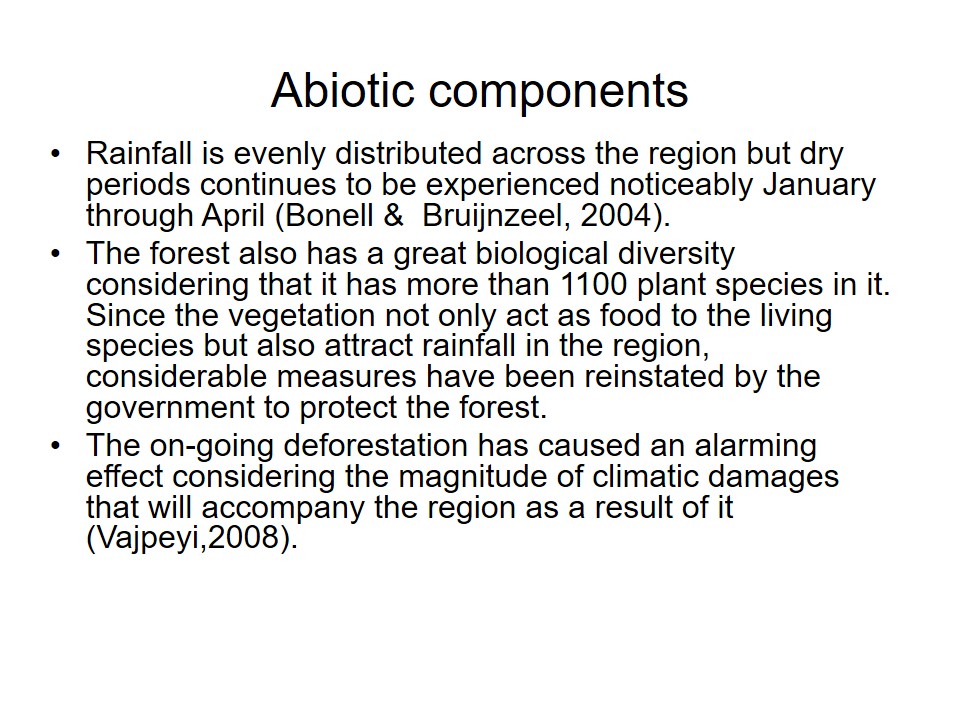
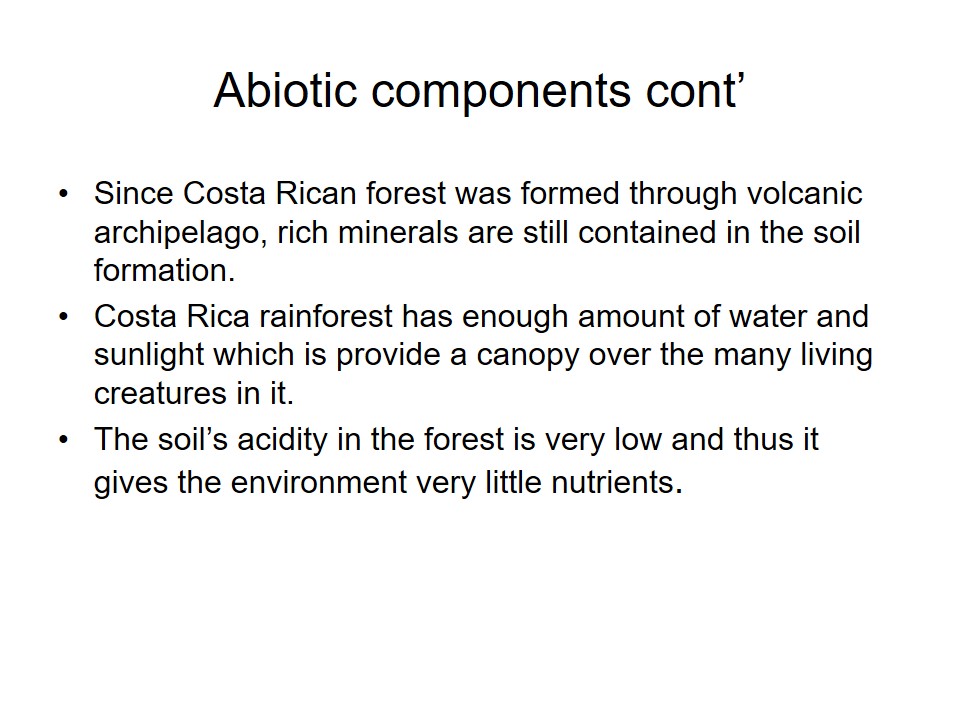
Biotic components
- Costa Rican forest has a variety of plants species ranging from sub-alpine vegetation, bamboo, vines and mangrove vegetation
- The epiphytes plants are also available within the forest and they add up water gathering ability of trees. Among the notable epiphytes in Costa Rican forest are orchids.
- There are also decomposers such as earthworms, fungi and bacteria which speed up the decomposition process in the forest.
- The Santa Rosa national park has a different mix of flora which lit up the region during the rainy seasons. Trees such us poro and corteza flowers during the rainy seasons.
- According to Erickson & Hance (2009), land crabs positively influence the growth and proliferation of the mangrove forest in this regions.
- Considering the biotic factors such as the omnivorous, herbivorous, carnivorous and the decomposers, the Costa Rican rain forest can be categorized as one of the major dwelling zones in the world.
- A long range of bird species such as resplendent quetzal, harpy eagle, parrots such as scarlet macaw are among the available species in the forest.
Among the biotic species of plant in Costa Rican forest include the Monteverde plants which absorbs moisture directly from the mist. The epiphytes and bromeliads joins the pacific swampland with different species of mangrove to form the flora and fauna.
Despite the fact that epiphytes live on trees in order to access sunlight they are not parasites since they feed on water, dust and nutrients which amass around their roots. Since the a biotic factors are the non-living factors which have a significant influence on the living organisms, the Costa Rican rain forest has a very conducive weather and ponds which inhabits varieties of organisms. The continued presence of rainfalls in the forest enhances food provisions for the species living within the forest region.
The Costa Rican rain forest has a biological diversity in plant and animal species. In addition the fungi and bacteria which assist in the decomposition process are equally available in the forest.
Since many of the land crab species are omnivorous, they have significant impacts on the terrestrial vegetation since they speed up the decomposition process and therefore benefit the soil (Erickson & Hance 2009).
The biotic factors also contribute to the increased tourism attraction in the area which benefits the government. Huge earnings are obtained by the government from both domestic and foreign tourists who occasionally visit the parks along side the Costa Rican forest in order to see the variety of wild species in the park.
The biotic factors also contribute to the increased tourism attraction in the area which benefits the government. Huge earnings are obtained by the government from both domestic and foreign tourists who occasionally visit the parks along side the Costa Rican forest in order to see the variety of wild species in the park.
Since the avbiotic factors are the non-living factors which have a significant influence on the living organisms, the Costa Rican rain forest has a very conducive weather and ponds which inhabits varieties of organisms. The continued presence of rainfalls in the forest enhances food provisions for the species living within the forest region.
The Costa Rican rain forest has a biological diversity in plant and animal species. In addition the fungi and bacteria which assist in the decomposition process are equally available in the forest.
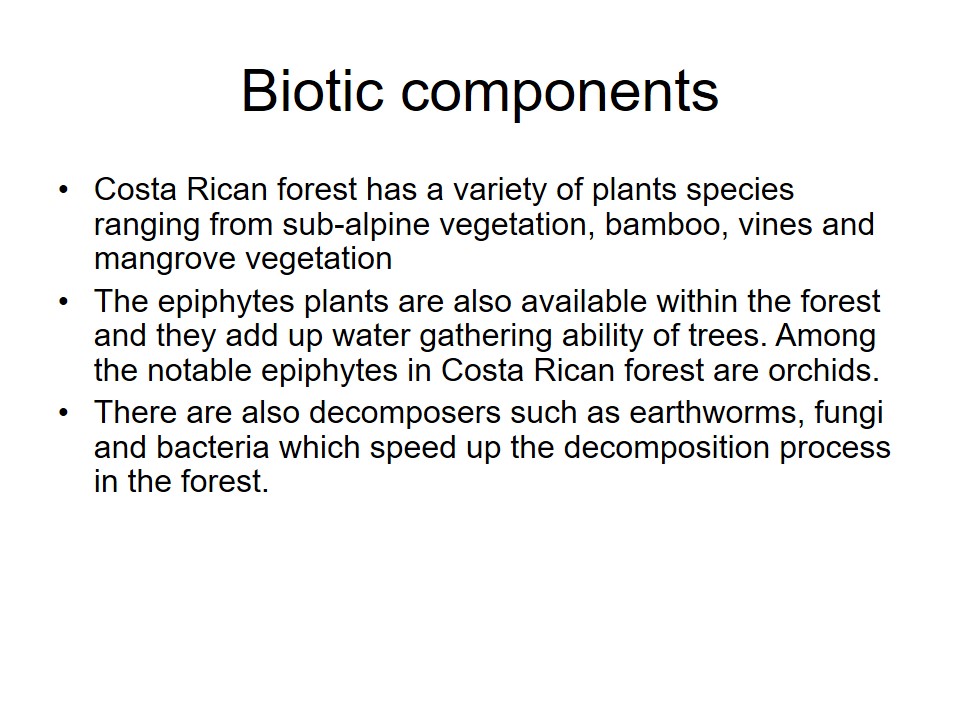
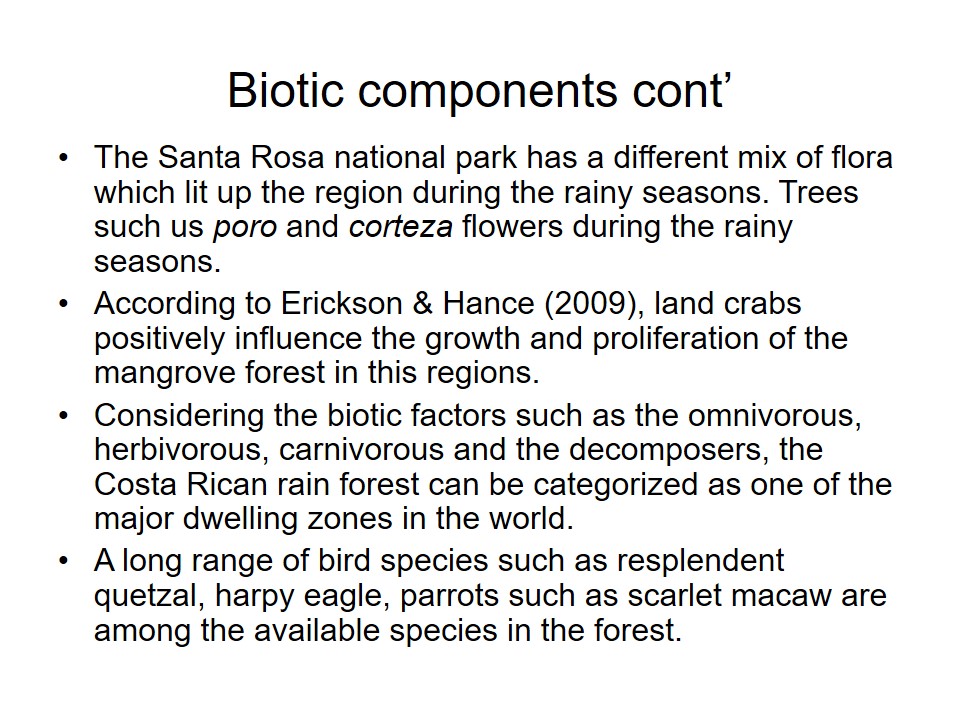
Impacts of human activities on ecosystem
- The forest is also a home to a notably four types of monkeys, the howler, spider, white-faced capuchin and the squirrel monkeys.
- Tourists are liable to see armadillos, agoutis, coatis, raccoons and wild pigs whenever they visit Costa Rican rainforest.
- Tourist destination centers like hotels and other recreational facilities have continuously threatened forest conservations. Regions around the Costa Rican rain forest have been characterized by increased hotels constructions.
- The general increase in population has raised wood fuel consumption significantly.
- The adoption and practices of modern sports which take place in forests has continued to threaten the wild species.
- Human activities has also contributed to a complete extinctions of jaguars and tapirs which are among the endangered species in the rainforests.
- The global warming effects have also emerged as one of the major threat to the current climatic changes in the world.
- Some of the swampy areas which initially used to inhabit quit a number of species have off late dried up due to the continued global warming effect.
- Mining activities have also threatened the security of Costa Rica rainforest as trees are cleared to facilitate transportation process.
Increased demand for furniture goods and medicines which are extracted from the forest has caused more harm to many rain forest Costa Rican being among them. Continued deforestation has been observed in the region as people seek place to construct their residential houses. As development extends in those areas urban centers have emerged therefore limiting further the forest space.
It is important to note that the continued industrialization process in the world has greatly hampered the climatic conditions in the world. As a result the frequent rainfalls which was experienced in the past are no more. Dry spells continue to be observed in most parts including rainforests.
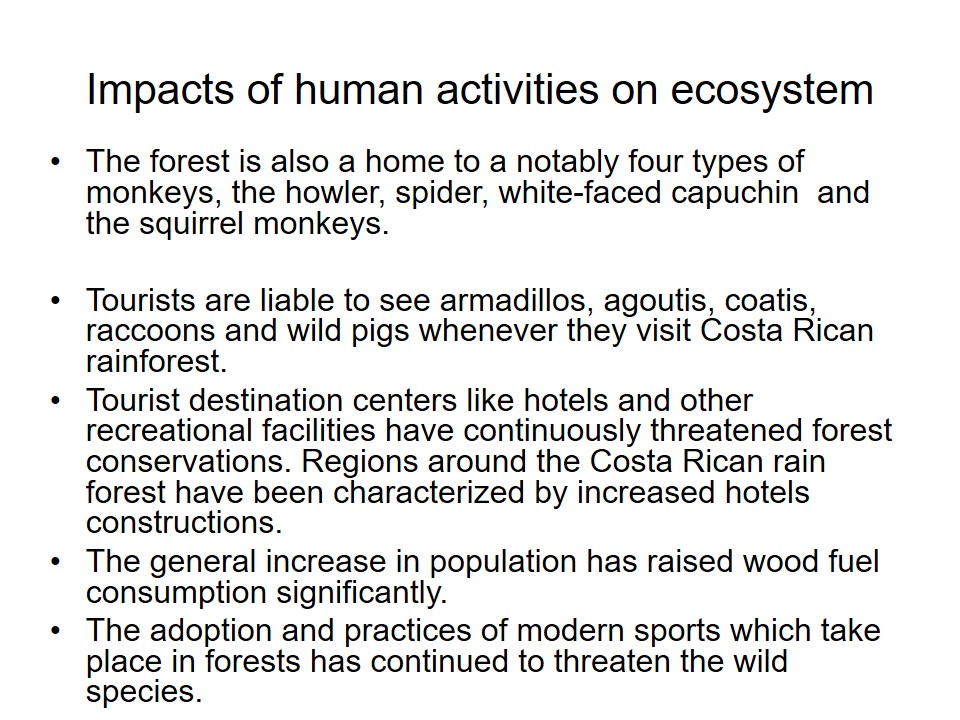
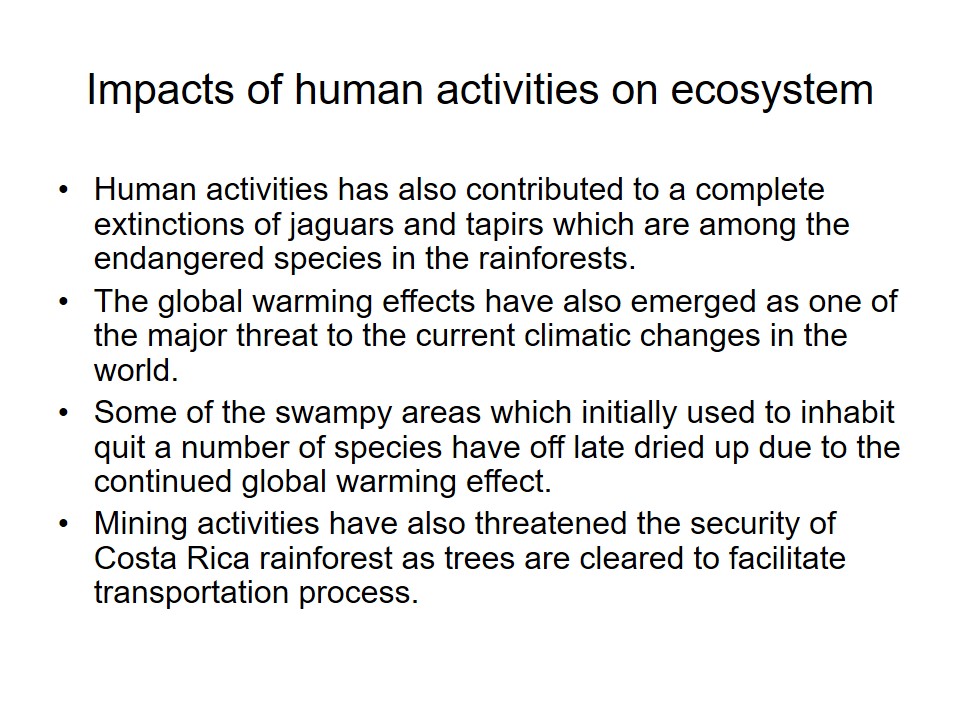
Potential future threats
- Severe damages will be felt both within the region and globally.
- The future generations will be denied access of some species in the forest which faces the extinction threat.
- The continued deforestation will significantly contribute to global warming if not checked.
- Growth in industrialization process also continues to be a major threat of environment. In some places acid rains are experienced.
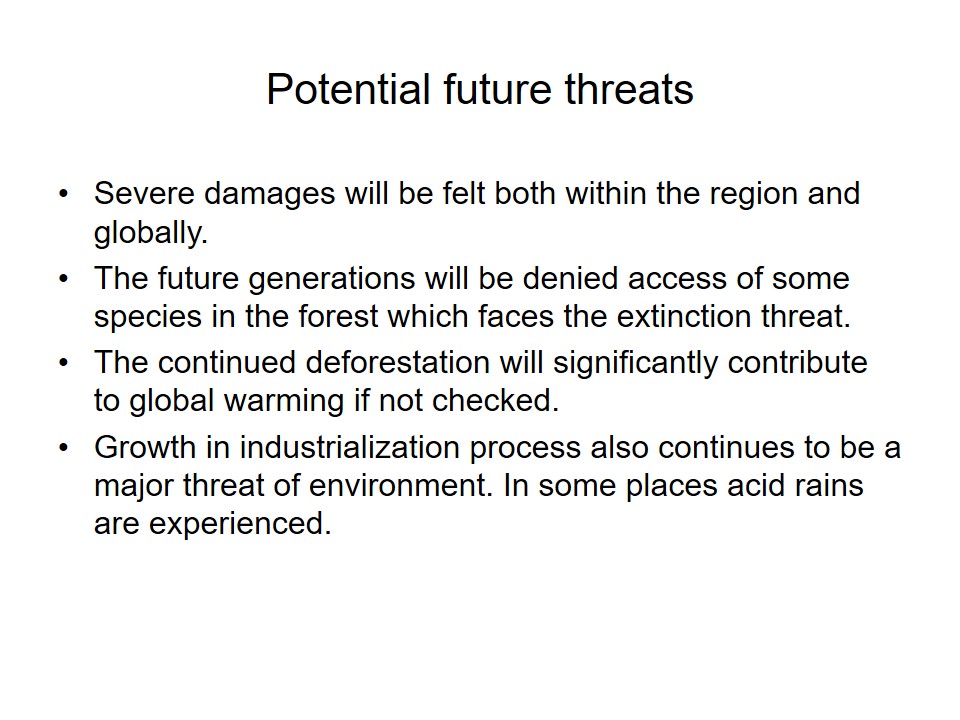
Conclusion
- Forest conservation is critical since it determines the increased climatic changes in the world.
- Costa Rican rain forest being one of such regions not only adds revenue to the government but it also betters the climatic conditions in the region.
- The government should therefore employ more strict consequences to the forest exploiters.
- Plans to relocate some of the hotels from the forest region should be underway to ensure forest conservations.
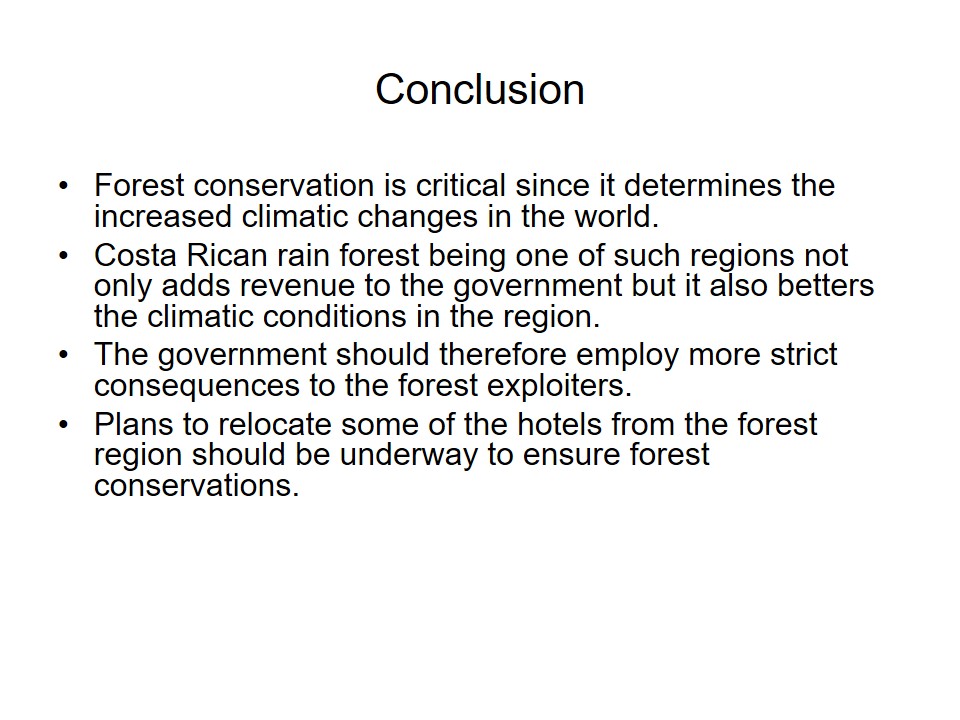
References
Bonell, M & Bruijnzeel, L. A. (2004). Forests, Water and People in the Humid Tropics: Past, Present and Future Hydrological Research for Integrated Land and Water Management. NY: Cambridge University Press. Web.
Erickson, M. D. & Hance, J. (2009). Protection of land crabs to the conservation of coastal tropical forest. MONGABAY. Web.
Vajpeyi, D. K. (2001). Deforestation, environment, and sustainable development: a comparative analysis. NY: Greenwood Publishing Group. Web.